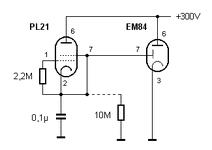neazoi
Advanced Member level 6

I am trying to build this circuit, to make a magic eye (EAM86 in my case) oscillate.
https://www-elektronik--labor-de.translate.goog/.../pl21...
I had to place a 10uF instead of 0.1uF, to decrease the frequency to around 1Hz.
Thyratron generates a sawtooth from 200 to 250v.
However the EAM86 beam, swings only a little and this swing is in the overlap region of the two beams (i.e beams not separated).
What can I do about it?
https://www-elektronik--labor-de.translate.goog/.../pl21...
I had to place a 10uF instead of 0.1uF, to decrease the frequency to around 1Hz.
Thyratron generates a sawtooth from 200 to 250v.
However the EAM86 beam, swings only a little and this swing is in the overlap region of the two beams (i.e beams not separated).
What can I do about it?

